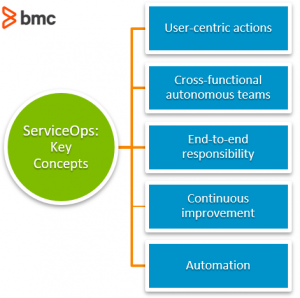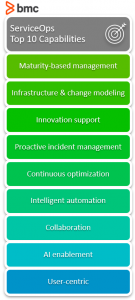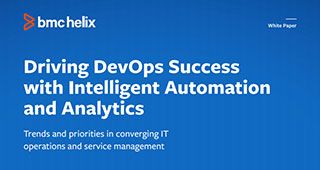ServiceOps is a new paradigm in enterprise technology: the convergence of service management and operations management. At its core, ServiceOps is about changing organizational culture, processes, and technology platforms in such ways to enable improved user experiences through real-time visibility, automation, and intelligent collaboration among otherwise siloed departments.
Let’s take a look at this emerging practice.

Key concepts of ServiceOps
ServiceOps pulls from several key principles of the popular DevOps and Agile frameworks, including:
- User-centric actions
- Collaboration and cross-functional autonomous teams
- End-to-end responsibility
- Continuous improvement
- Automation
By enabling service management and IT operations (ITOps) personnel to adopt these principles, IT organizations can deliver services and manage change effectively in highly complex IT environments.
In essence, ServiceOps enables organizations to replace their traditional reactive service and operations management model with processes and capabilities that are:
- Proactive
- Intelligent
- Effective
ServiceOps is about eliminating information, knowledge, technology, and organizational silos as cross-departmental teams serve collectively to deliver highly effective services and infrastructure resources across the end-to-end ITSM pipeline. Teams work collectively not only to mitigate incidents but also use advanced AI capabilities to identify incidents before they impact end-users.
In practice, ServiceOps technology unifies the people, processes, and technology solutions that are highly dependent on each other and must operate in parallel to ensure effective service delivery and incident-free infrastructure operations.
State of infrastructure & ITSM challenges
Before we discuss the key technology capabilities necessary to enable ServiceOps, we need to understand the current state of infrastructure operations and ITSM—including the key challenges. Recent research suggests that 67% of all enterprise infrastructure is cloud based:
- 81% of all enterprise organizations have already adopted or are developing a multi-cloud strategy.
- 82% of all IT workloads will reside in these multi-cloud environments.
The lack of modernized ITSM and ITOps management strategies is creating unprecedented challenges for these organizations.
Traditional ITSM and ITOps models are failing to keep up with the growing user demand for highly dependable IT services. IT is introducing infrastructure and process changes at astronomical rates. Log data metrics streams containing hidden information insights necessary to keep large, distributed, growing and complex infrastructure systems alive are also exploding in velocity, veracity, and volume at unmanageable levels.
From an IT Service Management and IT Operations Management perspective, these trends have resulted in these common challenges:
Large, complex environments
Modern IT infrastructure environments consist of multiple cloud and data center deployments.
- Hardware resources are often abstracted from the service layers through virtualization or software-oriented architectural design principles.
- IT workloads are distributed dynamically across complex IT environments to optimize for cost, security, performance, and dependability.
In these environments, a small configuration error, unfixed bug, or network infringement can have catastrophic effects across multiple services impacting a large user base. Thus, the incident response and QA process becomes inefficient due to:
- Complex control flows
- Non-deterministic failures
- Geographically disparate and distributed infrastructure deployments
Legacy & new applications running in parallel
Legacy apps, systems, and infrastructure are considered a bane to IT—especially when modern technology solutions deliver high value at low cost, even the performance of hybrid IT systems is bottlenecked by legacy systems.
Organizations are forced to maintain legacy systems as the cost and complexity of migrating to the cloud outweighs potential benefits. Lack of skills and hardware parts makes it challenging to maintain legacy systems. Therefore, legacy and modern apps and systems are operated in parallel. The result?
Neither operates to its maximum potential.
The challenge for the IT service management department is reflected in terms of growing service requests and incidents. Operations management becomes challenging due to lack of automation and inadequate integration. IT services are tightly coupled with the underlying hardware resources and often, individual components must be managed and maintained individually. Any performance issue with the component causes immediate impact on the end-user and hence contributes to rising service request tickets.
(Learn more about modernizing legacy software.)
Scalability & automation challenge
Hyper-scale IT services are crucial in the age of cloud computing and digital transformation.
Cloud-based service delivery models enable organizations to trade high CapEx for affordable OpEx on services that can be provisioned and scaled on a whim—infrequent high traffic peaks on mission-critical apps can be accommodated through additional resources with a few clicks or an automation script. Scalability has emerged as a leading driver to cloud migration, along with automation of service management and IT operations tasks as the necessary enabler to highly scalable IT operations.
But what happens when IT Ops are required to manually configure legacy systems?
Without automation, developers and Ops tackle changes and system components manually. Manual operations are error-prone and are likely to cause frequent and repeated service issues spanning a wide user base. Furthermore, scalability of operations or service support is inherently limited due to workforce limitations.
The siloed effect: change in traditional ITSM and ITOps space
A major challenge facing the IT Service Desk is the siloed service management functions. Exploding volumes of data and continuously evolving infrastructure systems and apps means that organizations must innovate continuously. IT is also expected to manage risk as new changes are introduced. From an end-user perspective, new features and innovations cannot emerge at the expense of service dependability and performance.
However, managing risks associated with changes—which are both inevitable and necessary—is challenging when information assets, knowledge, and the wider service management functions are siloed.
For instance, Ops teams would be occupied by backend infrastructure operations tasks, Service Desk teams would be busy handling support issues and ticket requests, whereas change management teams would struggle to integrate the efforts of siloed teams as they introduce and monitor new changes.
Top 10 ServiceOps capabilities
ServiceOps solves these challenges by empowering ITSM and ITOps teams with the information, cultural mindset, technology solutions, and framework designed for the modern technology-driven enterprise.
Key capabilities of ServiceOps solutions and framework include the following:

1. Maturity-based management
ServiceOps is about bringing service and operations management together by adopting new processes, workflows, technology solutions, organizational culture, and policies. To succeed with this change initiative, you should align your ServiceOps adoption with the maturity state of your organization, particularly the maturity of these areas:
- DevOps
- ITSM
- Digital transformation
Ideally, ServiceOps designs the service and operations management processes and workflows around the limitations and opportunities facing your organization. Based on your existing skillset, systems complexity, resource availability, and growth rate, ServiceOps assists organizations with the right set tooling and framework best practices at any given state of maturity.
ServiceOps further helps optimize the organization’s capacity and capabilities across the evolution phases.
2. Infrastructure & change modeling
When introducing a change, ServiceOps tooling models your IT infrastructure, systems and applications, and the performance. With this capability, IT can:
- Simulate the impact of change.
- Evaluate multiple change initiatives (instead of implementing them in real-world environments).
This information can help organizations evaluate and prepare for multiple future scenarios and reduce the risk associated with changes that impact business performance and end-user experience.
3. Innovation support
Organizations want to innovate and move faster. Frameworks such as DevOps encourage organizations to:
- Deliver ITSM and Ops capabilities
- Exploit data to make the right decisions
ServiceOps enables the innovation process by streamlining access to the right tools and data assets that were previously deployed and managed in isolation. A unified interface and centralized repository is a useful feature of ServiceOps tooling that integrates access and delivery of siloed information resources and systems.
(Explore our Guide to Enterprise Innovation.)
4. Proactive incident management
ServiceOps provides a unified workflow that integrates monitoring, data management, incident management, and a range of ITSM and ITOps functions. The result is accelerated root cause identification and issue resolution.
Data-driven analytics and advanced AI capabilities process a vast deluge of log metrics data generated at every node of the infrastructure. The information pipeline extends through the organization, enabling real-time tracking of system performance and collaboration between teams handling:
- The service desk
- Change management
- Infrastructure operations
- Development
- QA
Support requests and issue handling is optimally routed to the right teams at the right time. Patterns of incidents and anomalous behavior are tracked and mitigated before the issues grow beyond the handling capacity of the service desk.
5. Continuous optimization
Service management should continuously improve to ensure always online and real-time access of resources. Similar to achieving proactive incident resolution, the modern ITSM organization strives to innovate while reducing the risk associated with changes. However, service requests and incident related alerts only emerge after introducing a new change or infrastructure component.
Instead of waiting for user feedback in terms of service requests or infrastructure performance, ServiceOps solutions can help to:
- Predict system behavior
- Automate the process of incident resolution proactively
As the changes are introduced continuously, ServiceOps also continuously optimizes service and operations management functions.
6. Intelligent automation
ServiceOps is focused not only on replacing manual and repeatable tasks with automated solutions but to adopt intelligent automation capabilities. It aims to identify and eliminate waste processes that would adversely affect infrastructure performance and service delivery when automated.
ServiceOps is also focused on intelligent automation as a driver for scalability. For instance, ServiceOps prepares IT to automate infrastructure and operations management of hybrid IT systems including legacy and modern services. The tooling automates configurations and operations management such that minimal manual intervention is required, which in turn guarantees scalable ITOps processes.
7. Observable systems
ITOps struggle to control systems at the hardware level, especially when the services are abstracted and managed by third-party cloud vendors. So how do they prepare for potential incidents without sufficient visibility into underlying infrastructure systems?
ServiceOps takes two key measures that makes the infrastructure more observable:
- It simplifies the management complexity of an otherwise complex IT infrastructure system.
- It provides extensive tracing, logging, and analytics capabilities to help understand true infrastructure performance.
8. Collaboration
ServiceOps is about eliminating silos and taking end-to-end responsibility of the collective goals associated with service and operations management. It gives the information and capabilities that enable disparate teams to work together. For instance, ServiceOps tooling can:
- Alert multiple teams from IT, Dev, Ops, and ITSM functions.
- Provide a unified interface with relevant contextual information.
- Identify changes that may be necessary from an Ops or Service Desk standpoint.
These teams can then collaborate and devise a data-driven and informed decision on designing and deploying the necessary changes proactively.
9. AI enablement
Advanced AI and machine learning algorithms power ServiceOps capabilities in many applications. These include:
- Pattern recognition and anomaly detection
- Incident resolution
- Risk identification and
- Change management
Another interesting value proposition of AI-enabled ServiceOps solutions is the ability to model the infrastructure systems and simulate change scenarios. The modeling process is highly data-driven and advanced AI algorithms depend on vast log metrics to model accurate system behavior.
Therefore, ServiceOps is focused on synthesizing data and training AI models with the right information.
(Explore how AI can augment the human experience.)
10. User centric
Similar to DevOps, ServiceOps encourages organizations to develop an ITSM pipeline around user experience. ServiceOps motivates a feedback-driven approach to service and operations management. For instance, it supports a continuous release cycle that pushes new features and performance improvements as the user base grows and demands faster service desk support.
ServiceOps is not only about creating business value—it’s hyper-focused on improving customer satisfaction as the key enabler to better business. ServiceOps capabilities focused on scaling automated service desk support and maintaining highly dependable infrastructure systems further contribute to improved end-user experience.
ServiceOps use cases with BMC Helix
BMC enables ServiceOps with BMC Helix, the first and only intelligence-enriched, integrated service and operations platform.
Let’s look at some common use cases of ServiceOps solutions:
AIOps & AI service management
ServiceOps promotes intelligent ITSM and ITOps capabilities driven by AI/ML algorithms and real-time metrics data. As a result, ServiceOps becomes a true enabler to:
- AI-enabled ITSM
- AIOps
Together, these concepts ensure intelligent alerting, proactive incident resolution, root cause identification, and automated remediation. These processes require minimal human intervention and support an agile mindset for ITSM and operations management.
(Read our in-depth primers on AISM & AIOps.)
Process modeling & automation
ServiceOps therefore serves as an end-to-end environment optimization framework driven by AI to recommend changes and remediate risk management proactively. It supports existing service management and process automation according to the DevOps and Agile frameworks.
Swarm collaboration & converged platform
When an IT incident requires immediate attention of the ITSM and ITOps teams, the ServiceOps platform provides a unified interface for collaboration between previously siloed and geographically disparate teams.
The collaboration environment is similar to a swarming room where all teams gather to access all necessary data and services for immediate resolution. The converged platform unifies access to multiple common services such as single sign-on service data ingestion, service automation, and integration. Additional capabilities such as root cause isolation, data analysis, and chatbots can be further integrated into the platform, guiding the operational workflows toward automation and intelligence.







